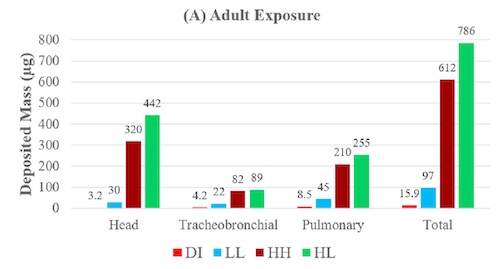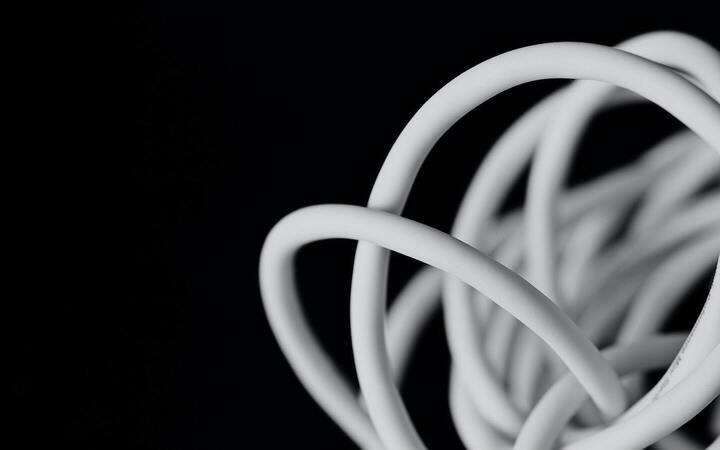Let me state two things upfront:
- It is possible to use ultrasonic humidifiers safely.
- Regardless of how they’re used, we don’t know for sure that ultrasonic humidifiers are dangerous.
Absolutely true! However, as typically used, ultrasonic humidifiers might cause health problems. This is supported by an abundance of peer-reviewed research papers. It’s also the quiet opinion of many different government agencies.
The good news is that the problem is trivial to solve: Steam and evaporative humidifiers don’t have the same issue.
We’ll start with an argument for being worried, then consider counter-arguments.
Particles can cause health problems
The evidence for this is strong. Outdoor particle levels vary throughout the world and statistics link these levels to health problems including heart disease, strokes, kidney disease, respiratory infections, and lung cancer. The mechanism appears to be that tiny particles make their way through the lungs into the bloodstream. These particles then activate the immune system causing all sorts of havoc. The idea that particles cause health problems is widely accepted (Wu et al, 2021).
A good heuristic is that an increase of 33.3 PM2.5 μg/m³ costs around 1 disability-adjusted life year. Correia et al. (2013) estimated something close to this from different counties in the US, and more recent data from many different countries confirm this. The most polluted cities in the world have levels around 100 PM2.5 μg/m³.
Ultrasonic humidifiers can create particles
Ultrasonic humidifiers create tiny droplets of water, including any dissolved solids. The water quickly evaporates, leaving the solids in the air.
Many peer-reviewed research papers have shown this can lead to high particle levels.
Ultrasonic humidifiers […] create tiny droplets consisting of water and its impurities. Once the water evaporates, the impurities can remain suspended as airborne particles. One of the primary concerns for household humidifiers is their ability to aerosolize pathogenic microbes. […] This white dust was associated with respiratory distress in children if inhaled
Ultrasonic humidifiers were found to have a substantial impact on home indoor concentrations and personal exposures for SO42- as well as PM2.5, likely as the result of aerosolization of sulfates and other dissolved minerals present in the water. For the two subjects with ultrasonic humidifiers, personal SO42- and PM exposures were approximately two and five times greater, respectively, than corresponding ambient concentrations.
When inhaled during an 8-hr exposure time, and depending on mineral water quality, humidifier aerosols can deposit up to 100s of μg minerals in the human child respiratory tract and 3–4.5 times more μg of minerals in human adult respiratory tract. […] Distilled water should be used whenever possible to prevent respiratory irritation (USEPA, 1991), although there is little indication that consumers are aware of or follow this consideration.
The ultrasonic humidifier has converted all the non-volatile solutes in tap water into PM. […] notice an unexpectedly high concentration of SO42- in PM […] We have detected a compound with a mass-to-charge ratio equivalent to that of azelaic acid or structure isomers. This result demonstrates the possibility that organic compounds can be associated with humidifier PM. […] Operating a single ultrasonic humidifier with tap water resulted in PM2.5 concentrations up to hundreds of μg/m³.
The concentrations of metals/elements varies based on particle size and particle water content. Nonetheless, the same relative amounts of metals/elements are present in each particle. Thus, inhalation of small particles increased mass exposure to common tap water metals (e.g., calcium, sodium, magnesium), and also associated anions.
Average indoor air particle concentrations were 211 μg/m³-air, based on ICP-MS metals and elements without bicarbonate, which exceed USEPA PM2.5 and PM10 values for ambient air.
Still not convinced? You can also read Wang et al. (2020) or Fleisch et al. (2018) or Baxter et al. (2007) or Umezawa et al. (2013) or Highsmith et al. (1988) or Richard Saint Cyr or Stack Exchange or Awair.
Still not convinced? Here’s a little experiment where I ran a humidifier near a particle counter for one minute. The video quality isn’t great, but you can hopefully see that levels rise from 5 to 86 PM2.5 μg/m³.
This isn’t controversial. This is a thing that happens.
Now, given the above data on humidifiers → particles and particles → health, you could estimate the potential cost of using an ultrasonic humidifier. I won’t do that calculation now because I don’t want to come across as alarmist. Instead, let’s look at some counterarguments.
Counterargument: Purified water
If there’s nothing dissolved in the water, then there won’t be anything for a humidifier to deposit in the air. For this not to be true would violate natural law, but for the empirical types, there’s also practical research.
Sain et al. (2017) and Yao et al. (2020) observe that different municipal water systems have levels of dissolved solids that can vary by a factor of 10. They find that the purer water creates about half the particles and using deionized water reduces particles by another factor of ⅔.
Lau et al. (2020) compare tap water, filtered water, distilled water, and deionized water. They find that filtered water reduces particles by around 20%, distilled water by 82%, and deionized by 90%.
Umezawa et al. (2013) compare tap water and ultrapure water, a type of water that’s typically used to make semiconductors, and is even purer than deionized water. They find that ultrapure water creates no detectable particles.
Counterargument: Different particles
Some types of particles are surely more dangerous than others. To take an extreme example, 100 μg/m³ of asbestos is a lot worse than 100 μg/m³ of calcium.
The statistics we have on ambient air pollution are based on particles from things like power plants and cars. The dissolved solids in water are different, so there’s every reason to think the health impact is different, too.
Some people make an evolutionary argument: Maybe we evolved some robustness to particles that are naturally occurring like those from dust or sea spray since our ancestors have been breathing those long before humans existed.
So what’s actually in water? Sain et al. (2017) do a decomposition of three different types of water. Here is what they find in terms of mg/L.
| mineral | low solids + low hardness | high solids + low hardness | high solids + high hardness |
|---|---|---|---|
| CaCO3 | 35 | 267 | 273 |
| Ca | 11.9 | 9.6 | 55 |
| Na | 10.5 | 204 | 112 |
| Mg | 5.2 | 4.0 | 24.8 |
| Si | 2.9 | 3.7 | 3.7 |
| K | 2.8 | 28.4 | 11.4 |
| Cu | .124 | .047 | .112 |
| Mn | .075 | .038 | .043 |
| Zn | .069 | .035 | .052 |
| Sr | .062 | .043 | .060 |
| Ba | .024 | .020 | .021 |
Most of these chemicals occur naturally in the body. So maybe if you inhale them, they’ll just get absorbed and your body won’t even really notice.
Maybe. I take these counterarguments seriously. Certainly, purified water is safer, and it’s reasonable to decrease your estimate of harm based on what chemicals are actually in the water. But:
We have a poor understanding of how particles cause harms
Surprisingly, the biggest problems are cardiovascular disease and diabetes, not in the lungs. The going theory is that small particles pass through the lungs into the bloodstream and activate the immune system. Our understanding of how this works is highly imperfect.
So we just don’t know what the effects of breathing that stuff are. My guess is that the harms are lower than with the average particles in air pollution. But how much? The worst-case estimates are so high that you need a very heavy discount for the risk to be negligible.
There’s also some evidence that after the particles from water get into the lungs, they don’t just get absorbed and have no effect. Umezawa et al. (2013) exposed mice to the particles from ultrasonic humidifiers with either ultrapure water or high silica water for 14 days. They then extracted lung tissue and ran RNA microarrays to see the relative expression of different genes and pathways:
Are these bad? I have no idea, but the official Dynomight Biologist says it looks like an immune reaction. (If you read the paper they also talk about scary-sounding stuff like asthma and thyroid disease pathways being enriched but I think this is meaningless.) At a minimum this shows that the particles do something and that’s worrying.
Humidifiers are a breeding ground
Most of the above experiments miss a big potential concern with ultrasonic humidifiers: Bacteria and fungus buildup happen within days, and once they’ve taken hold, they are almost impossible to fully remove. This was shown by Grieble et al. (1970) who concluded that daily sterilization was the only way to avoid the problem. Recent research (Yang et al., 2021 Tyndall et al., 1995, Suda et al., 1995) came to similar conclusions.
Now, are these bacteria bad? Again, we don’t know for sure. And, of course, we breathe lots of bacteria all the time. But these are different bacteria, being delivered to the body in a way that never happened in our evolutionary history. And obviously, the immune system is designed to activate in the presence of bacteria.
Few people use ultrasonic humidifiers as recommended
How are you supposed to use a humidifier? We can ask the manufacturers. (You carefully read and follow the instructions for every appliance you buy, right?)
Note: To avoid possible white dust due to hard water it is recommended to use distilled water. […] DO NOT leave water in water tank or water basin when unit is not in use as it may result in the build up of mineral deposits and bacteria that can inhibit the output efficiency of the humidifier. PLEASE NOTE that if water remains in the water tank for more than a day or two, bacterial growth is possible.
Only fill the water tank with distilled water. Never fill the water tank with any other liquids. […] You should clean the humidifier every 3 days. Change the water every day or every other day to avoid bacteria growth. […] Fill the tank with 710 mL / 3 cups of distilled white vinegar. Replace the cap and gently shake to coat all sides of the water tank. Allow it to sit for at least 1 hour.
To keep your humidifier running efficiently, clean it regularly. Weekly cleaning is recommended. […] Mix 1 gallon (3.8L) of water with 1 teaspoon of bleach. Pour the bleach solution into the Tank. […] If you live in a hard water area, the use of distilled water or a demineralization cartridge with tap water will help minimize the production of white dust.
It is recommended, assuming average use, to thoroughly clean weekly or when algae, mineral deposits or other particles begin to form. If the humidifier is turned off with water in the base and not turned back on for 8 hours or longer, or if humidifier is not cleaned as recommended, you may experience some growth of algae or bacteria. These microorganisms may become airborne.
IMPORTANT: If you do not plan to use your humidifier for two or more days, make sure any residual water is drained from the tank and base to prevent any bacteria growth in stagnant water.
The EPA gives similar advice: Use distilled water; empty and dry, and clean after each use; and disinfect regularly. The NIH goes even further (emphasis mine):
At the NIH Clinical Center, a 240-bed clinical research hospital, policy allows patients to request bedside humidifiers, but stipulates that the humidifiers must be filled with sterile water and the humidifier must be discarded after 3 days of use.
You get the point. The idea that that minerals in water or bacteria might be problematic isn’t a kooky conspiracy theory. It’s the accepted view, just not (currently) well-known.
Cost/benefit
Again, an ultrasonic humidifier can be used safely. Several people have told me that they use some combination of distilled or deionized water + cleaning + filters + demineralization cartridges + air purifiers and they’ve verified with a particle counter that particle levels are near zero. If that’s what you’re doing and you’re happy with it, great!
But many other people have told me they thought everything was fine but when they measured particles, they were through the roof. The only way to really be safe with an ultrasonic humidifier is to regularly test with a particle counter.
If you don’t want to do all that, the good news is that steam and evaporative humidifiers humidify the air just as well and there’s tons of evidence that they create almost no particles (See Park et al. (2020) or Paschold et al. (2003) or Highsmith et al. (1988) or the EPA or public health Ontario or the VA’s policy to prohibit ultrasonic humidifiers but allow steam.)
Now personally, I can’t understand how dealing with distilled or deionized water—yes there are people who actually use deionized water—plus sanitizing plus measuring particles is better than just buying a different humidifier, but I won’t question your values.
So, finally, let’s do some calculations. Let’s start with something reassuring: Even with very pessimistic assumptions, an ultrasonic humidifier isn’t going to instantly kill you. One heuristic is that if you were exposed to an (insanely high) level of 2500 PM2.5, you’d lose disability-adjusted life roughly “in real-time”. If you use a humidifier for one night and it creates a level of 300 PM2.5, this suggests you lose only
8 hours × 300 / 2500 ≈ 1 hour.
That’s hardly the end of the world, but it adds up. Say you used that same humidifier every night of your life. Remembering that an average exposure of 33 μg/m³ costs one disability-adjusted life year (DALY) that suggests the cost would be
300 μg/m³ × (8 / 24) × (1 DALY / 33.3 μg/m³) = 3 DALY.
You’ll want to adjust this number. Most people don’t use a humidifier all year and you might think that the harms are lower because the chemical/bacterial/fungal composition of water is less bad than the particles produced by cars/fires/power plants.
But what would an optimistic calculation be? Let’s say that you use an ultrasonic humidifier for 1/3 of the year, you’re 50% sure the particles are harmless, and if they are harmful, you think they’re only half as bad as typical air pollution. Then, the expected harm is
3 DALY × ⅓ × ½ × ½ = 90 disability-adjusted life days.
That’s not that much, but it’s the same order of magnitude as the benefit of taking statins. If the only alternative were dry air, I can see how you might just take the hit. But when the alternative is to buy a different type of humidifier…















